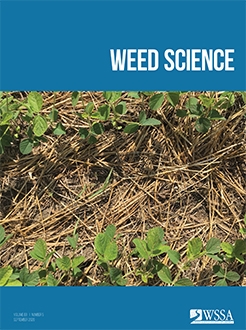The developmental status of perennial weeds such as rush skeletonweed (Chondrilla juncea L.) can influence herbicide absorption and translocation. Differential efficacy between fall and spring applications suggests vernalization impacts herbicide absorption and translocation in other perennial asters. Clopyralid and aminopyralid absorption and translocation were quantified in nonvernalized and vernalized plants following application of 14C-labeled herbicides 2, 4, 8, 24, and 72 h after treatment. Less 14C clopyralid was absorbed, and at a slower rate, in vernalized plants. Movement out of the treated leaf was slower, with 14C clopyralid translocating more rapidly than 14C aminopyralid. More 14C moved to the roots in nonvernalized plants compared with vernalized plants, regardless of herbicide. Increased translocation to belowground survival structures is needed for effective control of C. juncea.
How to translate text using browser tools
19 June 2020
Vernalization Affects Absorption and Translocation of Clopyralid and Aminopyralid in Rush Skeletonweed (Chondrilla juncea)
Tara L. Burke,
Ian C. Burke
ACCESS THE FULL ARTICLE

Weed Science
Vol. 68 • No. 5
September 2020
Vol. 68 • No. 5
September 2020
Auxinic herbicides
herbicide physiology
herbicide uptake
Perennial weed control
source–sink relationship





